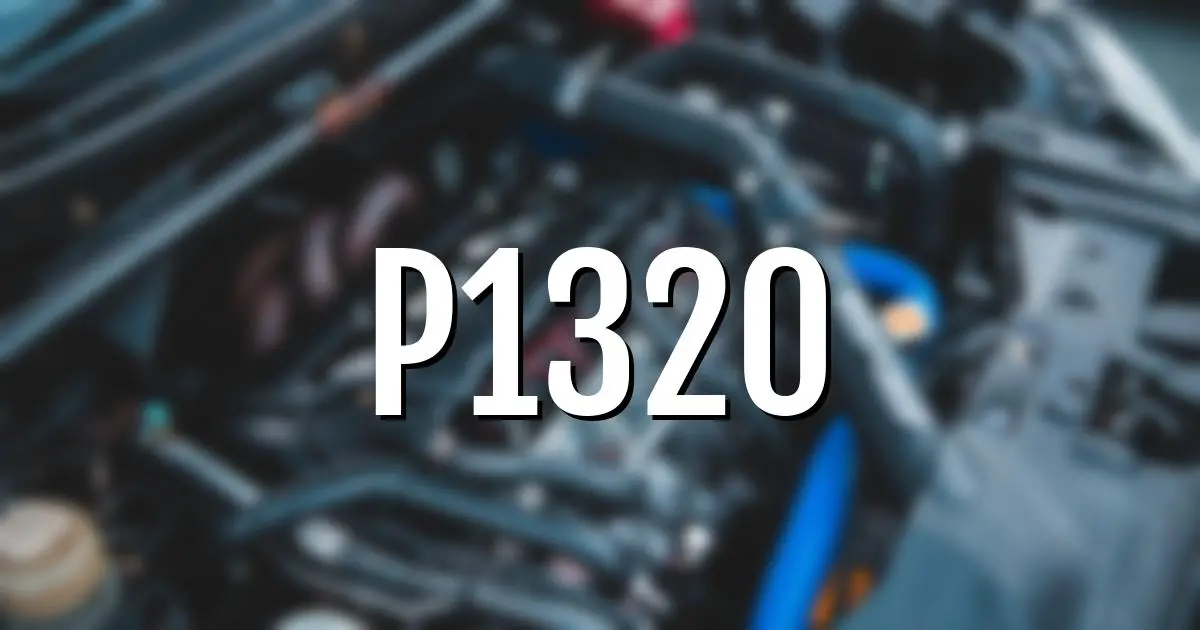The automobile fault code P1320 indicates a problem with the ignition system.
The symptoms may include rough idling, misfires, and difficulty starting the engine.
The most common cause is a faulty power transistor unit built into the ignition coil. Other possible causes include an open or shorted ignition primary circuit, poor electrical connections, a faulty ignition system condenser, or an issue with the crankshaft position sensor circuit. To fix the problem, you should visually inspect the wiring harness and connectors for any damage.
Look for broken, bent, pushed out, or corroded pins on the connectors.
The repair time for this issue is estimated to be around 1.0 hour.
| Repair Importance Level | 10.0 (Out of 10) |
| Estimated Repair Time | Approximately 1.0 hour |
| Repair Difficulty Level | 10.0 (Out of 10) |
Decode P1320: Unveiling The Symptoms Of This Automobile Fault Code
Experiencing rough idling, misfires, and difficulty starting?
Check out the symptoms of the automobile fault code p1320 below.
- The symptoms of the automobile fault code P1320 include engine misfires, rough idling, hesitation or stumbling during acceleration, loss of power, and difficulty starting the vehicle.
- Additionally, there may be an illuminated check engine light, reduced fuel efficiency, and increased emissions.
- It is important to address these symptoms promptly to prevent further damage to the engine and ensure optimal performance of the vehicle.
Unraveling The Mystery: What Causes Fault Code P1320?
The automobile fault code P1320 can be caused by a faulty power transistor unit, open or shorted ignition primary circuit, poor electrical connection, faulty ignition system condenser, or issues with the crankshaft position sensor circuit.
- The fault code P1320 can be caused by a faulty power transistor unit built into the ignition coil, an open or shorted ignition primary circuit (circuit to ignition coils), a poor electrical connection in the ignition primary circuit (circuit to ignition coils), a faulty ignition system condenser, or an issue with the crankshaft position sensor circuit.
Fixing Code P1320: Simple Steps To Get Your Car Running Smoothly!
To fix the p1320 fault code, start by visually inspecting the wiring harness, connectors, and components for any damage or corrosion.
- To fix the automobile fault code P1320, you need to follow these steps: 1.
- Check the possible causes mentioned above.
- 2.
- Visually inspect the wiring harness and connectors related to the fault code.
- 3.
- Look for any damaged components.
- 4.
- Check for broken, bent, pushed out, or corroded pins in the connectors.
- The estimated repair time for this fix is 1.0 hour.
Cracking The Code: P1320 – Cost And Complexity Unveiled!
The factors influencing the cost of diagnosing and fixing the automobile fault code p1320 are the estimated repair time of 1.0 hour and the hourly rate charged by auto repair shops, which typically ranges between $75 and $150.
Decode P1320: Unveiling Symptoms And Solutions
When you see the Engine Light ON or the Service Engine Soon Warning Light, it could be due to the fault code P1320. This code indicates an ignition coil issue in your automobile. Ignition coils are responsible for generating the high voltage needed to ignite the fuel mixture in the engine cylinders.
When the P1320 code appears, it means that there is a problem with the ignition coil or its circuitry. Ignoring this issue can lead to poor engine performance, misfires, and potential damage to other engine components. It is important to address this fault code promptly to ensure the smooth operation of your vehicle.
FAQ
The automobile fault code P1320 can be caused by a few different factors. One possible cause is a faulty power transistor unit built into the ignition coil. Another potential cause is an open or shorted ignition primary circuit, which refers to the circuit that connects to the ignition coils. Poor electrical connections in the ignition primary circuit can also trigger this fault code. Additionally, a faulty ignition system condenser or an issue with the crankshaft position sensor circuit can be to blame. To fix this issue, it is recommended to visually inspect the wiring harness and connectors, checking for any damage or corrosion. It is also important to look for any broken, bent, pushed out, or corroded pins in the connectors.
To fix the P1320 fault code, start by visually inspecting the wiring harness and connectors. Look for any damaged components and check if there are any broken, bent, pushed out, or corroded pins in the connectors. This will help identify any issues with the faulty power transistor unit built into the ignition coil, open or shorted ignition primary circuit, poor electrical connection in the ignition primary circuit, faulty ignition system condenser, or crankshaft position sensor circuit. Take note of any findings to determine the appropriate fix.
To resolve the P1320 fault code, start by visually inspecting the wiring harness and connectors. Look for any damaged components and check for broken, bent, pushed out, or corroded connector pins. This will help identify any issues with the faulty power transistor unit built into the ignition coil, open or shorted ignition primary circuit, poor electrical connection in the ignition primary circuit, faulty ignition system condenser, or the crankshaft position sensor circuit. Take note of any findings to determine the appropriate fix.

Wrap Up
If you’re experiencing issues with your vehicle such as poor engine performance or difficulty starting, the P1320 fault code may be the culprit. This code is typically caused by a faulty power transistor unit built into the ignition coil, an open or shorted ignition primary circuit, poor electrical connections, a faulty ignition system condenser, or a problem with the crankshaft position sensor circuit.
To fix this issue, visually inspect the wiring harness and connectors for any damage, and check for broken, bent, pushed out, or corroded connector pins.
